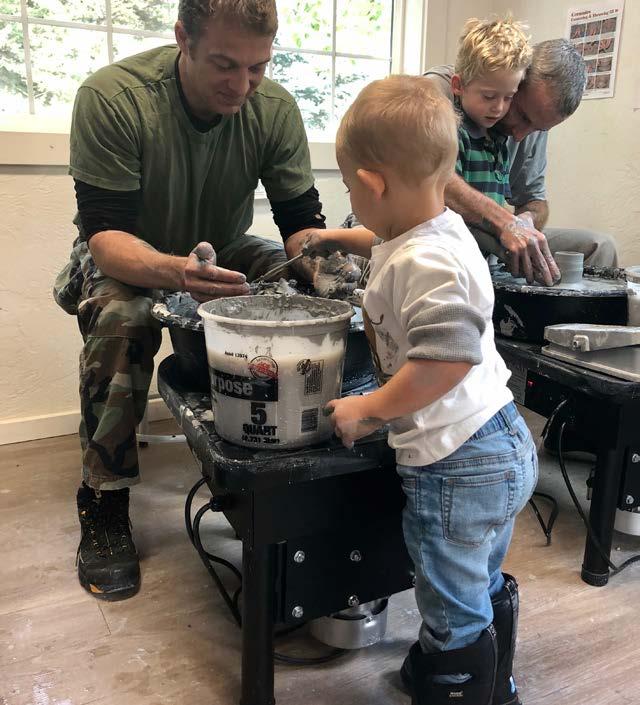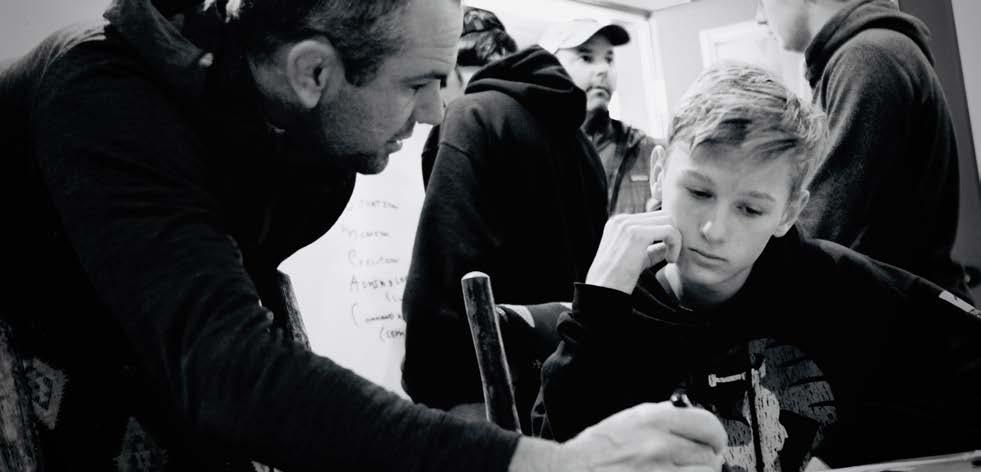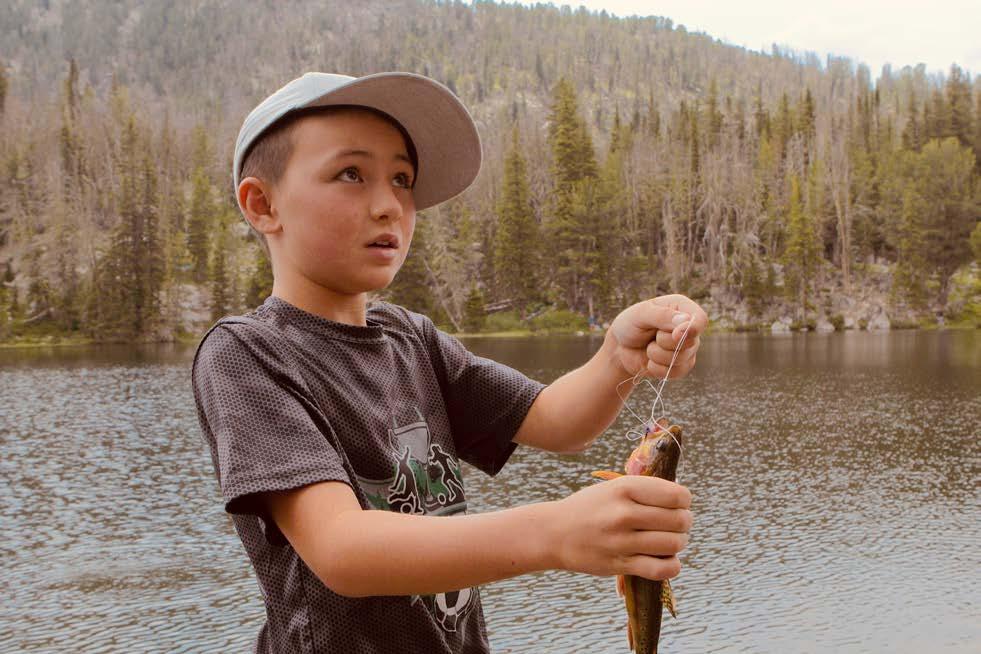EMOTION COACHING
CREATING FORTIFIED FAMILIES, HELPING CHILDREN DEVELOP STRENGTH AND RESILIENCE

FOR PARTICIPANT’S
PURPOSES ONLY.
COPY OR DISSEMINATE ANY OF THIS MATERIAL IN ANY FORM.
The Station Foundation. All rights reserved.


FOR PARTICIPANT’S
PURPOSES ONLY.
COPY OR DISSEMINATE ANY OF THIS MATERIAL IN ANY FORM.
The Station Foundation. All rights reserved.
This four week virtual workshop explores how mindfulness helps individuals work through difficult emotions and conflict. Participants receive and learn tools to help increase awareness, identity emotions, and tap into self-regulation. Parents learn to recognize a child’s expression of emotion as opportunity for connection. Teaching parents and children how to grow together through emotional experiences results in deep connection, trust, and healthy discipline dynamics.

©2022 The Station Foundation. All rights reserved.
Emotion Coaching creates a neurological change in children’s brains that allows them to self-soothe and improve focus.
1. Children were able to focus better, sustain their focus, and/or shift their attention as needed.
They had higher reading and math scores at age eight than all the other children.
They demonstrated more self-regulation through self soothing techniques, improved impulse control, and calmed self more quickly and easily when they were upset.
Researchers speculate that practicing emotion coaching improves children’s ability to calm their heart rate more quickly, which may lead to fewer infectious illnesses.
They were better at delaying gratification. This ability, in other research, is related later to higher SAT scores, better college performance, and better adult relationships.
They were better at motivating themselves.
They could cope better with life’s ups and downs.
They required less discipline.
They had healthier peer relationships.
©2022 The Station Foundation. All rights reserved.










©2022 The Station Foundation. All rights reserved.

When we are upset, angry, frustrated or emotionally taxed, we lose our ability to effectively reason and problem solve. The body and mind become overwhelmed or “flooded”, and the brain’s natural defense is to secrete high amounts of cortisol and adrenaline in a state of fight or flight to protect itself from a perceived threat. Without taking a break or a time out, our ability to effectively process a situation becomes stifled. We can remain stuck in a frustrated, negative mental rut.

Recognizing that you are flooded takes self awareness. Self soothing requires practice and experimenting with what suits you best. Talking with your spouse as well as your children about flooding helps equip your family with the words to describe when someone needs a break to regroup. Perhaps you discuss and agree on a signal or catch phrase that lets your family know that you need some time to emotionally reset. Taking a break is not avoiding conflict; it is insurance that you will return to discuss and work through conflict with more clarity, cre ativity, and perspective than attempting to problem solve when feeling overwhelmed or heated.
You are, however, equipped with tools to help you calm down and reset. Taking a 20 minute break to self soothe is a simple and effective way to regain composure. Some great ways to self soothe include:
Belly breathing Listening to soothing music Going for a walk
Stepping outside Practicing yoga Reading for pleasure
From tiny tots to driving teens, our children experience a wide range of emotions. The good news is that parents can help their children work through feelings of frustration, anger, disappointment, and other big emotions.

As parents, we have the opportunity and responsibility to teach appropriate ways to respond to those feelings. We can improve our children’s self-awareness and self-control by modeling, practicing, and encouraging these skills ourselves.
Finding activities to soothe your children requires creative exploration and curiosity. What works for one child may not be the best method for their sibling and that’s typical.
Exploring these various activities with openness allows for an informal assessment of what resonates with each individual child and soothes them.
How can I help ease my three-year-old daughter’s frustration with getting herself dressed each morning? The daily melt downs are exhausting!Photo by Youssef Abdelwahab on Unsplash
Through a combination of creative exploration or perhaps some trial and error in the heat of a tantrum, you will be able to discern which activities resonate best with your child.
For example, you may discover that kicking a soccer ball back and forth calms your teenager when he’s angry, that he prefers listening to soothing music when he’s overwhelmed with schoolwork, and that watching an episode of his favorite sit-com provides the laughter reset he needs when feeling left out or disappointed by his peers.

How should I respond to my teenage son who just slammed his bedroom door because he felt embarrassed at school today? He’s seething in angry frustration.Photo by Aleksandr Gorin on Unsplash
Jump on a trampoline Bounce a ball Play jumping jacks Hang upside down Play hopscotch Running sprints in the backyard Going for a bike ride Dance Kick a soccer ball against a wall, garage door, or practice passing with a buddy
Pull weeds Walk barefoot in grass Observe the breeze on your face; notice how it smells; notice the sun’s warmth Lay down and observe the stars Lay down and look for figures/shapes within the clouds
Squish playdough Twist pipe cleaners Pop bubble wrap (with hands or feet) Squeeze a stress ball Wrap arms around self and squeeze Put palms together, push and release Complete push-ups against a wall Provide a firm, deep pressure hug Beat on a drum Snuggle your pet
Make a Glitter Jar* Listen to soothing music Draw a picture of how you feel today Color in a coloring book Create an inviting “Chill Out Corner” with pillows, a favorite stuffed animal, and a few favorite books to allow for a quiet reset in this space
*https://heartmindkids.com/how-to-make-a-glitter-jar-for-mindfulness/
Blow bubbles outside Blow on a feather Trace Finger Breathing (Raise one hand in front of your chest. Trace up and down the outside and inside of your fingers, working along each finger. Inhale on the way up towards the fingertip, and exhale as you move your finger down towards the base of the hand.)
Blow a Pom-Pom around with a straw Blow bubbles in a cup Blow dandelions
Over time, you will learn a handful of soothing practices that work well for each child in various circumstances. Gentle encouragement in the form of a casual invitation is well received by adolescents and teens:

“Hey, are you up for shooting some hoops with me? Today was a tough day, and this may be a good way to blow off some steam.”
“How about we take a break and go for a quick bike ride together? Getting some fresh air will give us both a mental break, and when we come back, we can work through this chemistry homework together.”
“I know you are stressed out about tomorrow’s big test. Would you like to go for a run together to clear your mind?”
Young children appreciate the responsibility of making choices, so when you have established a small repertoire of effective methods and you observe a big emotion, encourage your child to make a choice such as:
“I heard you yelling and stomping. It sounds like you are really upset. Would you like to come here for a big hug or would you like to go outside and jump on the trampoline?”
“I am sorr y your brother broke your toy car. I understand why you are mad that it doesn’t work right now. Your face looks mad, and your voice sounds angry. Would you rather squish some Playdough with me or pop some Bubble Wrap?”
Introduce and practice some of these activities when things are calm so that children begin to establish a comfort level and familiarity. Approach these activities with curiosity, and casually observe the outcome with no expectations. Some activities may prove to be very calming, and others may not be the right fit; that’s okay and remember to breathe.
Invite your child/children to participate with you with a phrase such as: “Oof, I feel really frustrated. Nothing seems to be going my way today. I feel like I need to move my body to feel better. Want to play outside with me?”
“I’m feeling mad right now. Listening to music will help me calm down. Let’s turn on the Curious George CD and dance together.”
“I feel sad today. I think laying down by Farley and petting her will help me feel better. Let’s lay down and give Farley some snuggles. I wonder if that will comfort me.”
A short sentence or two draws the connection between the chosen activity and how it will offer some relief.
Coming out of a heightened state of arousal takes 15-20 minutes, so plan accordingly. Whatever the selected activity may be, use that time to help your child reduce their emotional intensity level. We do not want them to continue to stew in anger, plot revenge, prepare counter arguments when retreating to a quiet space, nor are we trying to dismiss or suppress big emotions.
Instead, we want to encourage our children to use the time to move from operating in the sympathetic nervous system response of fight/flight/freeze into the parasympathetic nervous system of rest/digest. When the emotions decrease in intensity, your child will be more receptive to conversation and problem solving together.
For more information about the sympathetic and parasympathetic nervous system, please refer to page one of the Experience the Power of Breath booklet.
©2022 The Station Foundation. All rights reserved.
Tempers get short, patience wears thin – we take two steps forward and one step back. There might be gains Sunday, but come Monday we find ourselves battling again and in need of a reset.

When it comes to implementing Emotion Coaching, it takes practice. Lots of practice. Below are a few examples of integrating Emotion Coaching when redirecting your child’s behavior.
If you feel flooded, pause and step away from the situation for a moment to avoid responding aggressively or regrettably.
Process is everything. If parents want their children to be kind to others, then parents must set that example and treat their kids with kindness. Parents who interact respectfully with their children receive respect in return.
EXAMPLE You are on the phone, and your four year old is running through the room making a lot of noise trying to get your attention. The noise is building, and your frustration is rising to a boiling point. instead of “Quiet! Can’t you see I’m on the phone for work?”
emotion coaching response (Channel your inner Bruce Banner to avoid a Hulk Smash moment). �� “ I am on the phone and need to finish this conversation. Please play quietly so I can concentrate. I will give you my attention in just a minute. Thank you.”
Do not use threats or insults. Avoid labeling your child with criticism or contempt.
Criticism is pointing out something negative in your child or blaming your child for a problem by naming his or her personality flaws. Criticism makes them feel as though something is wrong with them. Examples of criticism include: “You are very selfish.” “Why don’t you behave?” “Why can’t you be nice? ” “ You always… ” “ You never… ” Contempt is a statement made to another person from a place of superiority in order to put that other person down. This includes sarcasm, mockery and name calling.
EXAMPLE Milk spills on the floor
instead of “What is wrong with you? You’re so clumsy. You always spill.”
emotion coaching response “I see the milk spilled. It needs to be cleaned up. Here’s a paper towel to clean up the mess. Next time, please move the cup away from the edge of the table.”
EXAMPLE I saw you hit your sister and seeing that makes me feel sad and frustrated.
Let the child know what is acceptable and unacceptable.
EXAMPLE “ Hitting hurts. We do not hit each other in this family. I know she was irritating you, and we can talk about how to work through that together. Hitting someone when you are upset is not okay.”
Be direct, fair and consistent with consequences.
Express your message clearly and confidently. Include a way that your child can redeem himself or herself. EXAMPLE (Preschool aged) “ Because you hit your sister, you are in Time Out for four minutes. You are going to sit quietly without playing with toys or books. When the timer goes off, we are going to talk about what you can do instead of hitting when you feel angry.
Small punishments are the most effective.
Remember that your disapproval is the most powerful punishment the child can experience due to the emotional distance it creates for him or her.
Ask your child, "What do YOU think you should do?".
Encourage your child to come up with their own solution to the problem. Patiently wait for their response rather than interject. When children are given opportunities to solve problems and self soothe as they work through challenges, they grow in self confidence and emotional regulation. When you express that you trust their abilities to problem solve, your connection deepens.
©2022 The Station Foundation. All rights reserved.

Become aware of the emotion and identify where you sense it in your body.
To stay mindful, say to yourself “This is anger” or “This is anxiety”.
Don’t deny the emotion. Acknowledge and accept that is is there.
Even if the emotion feels overwhelming, remember that it will pass.
Ask yourself, “What triggered me?” “Why do I feel this way?”.
Be open to the outocme of your emotions and what unfolds.
Once you become aware of the emotion you are feeling, notice where it is in your body. You may feel it as a stomachache, a tightening of your throat, the pounding of your heart, or tension somewhere. Sit with this anger, anxiety, depression, grief, guilt, sadness, shame, or whatever emotion you are experiencing. Become aware of it and don’t ignore it. If this is difficult, get up and walk around or get a cup of tea.
The key here is to not push the emotion away. Bottling it up inside will only cause it to bubble up and explode later, resulting in more difficult emotions or even a complete emotional shutdown. Listen to your difficult emo tions. They are trying to help you wake up to what is going on before a major crisis occurs.
Instead of saying, “I am angry”, say, “This is anger” or, “This is anxiety.” In this way, you’re acknowledging its presence, while simultaneously empowering yourself to remain detached from it.
When my husband was in the hospital before he passed, I felt a deep sense of uncertainty, anxiety, and fear. I needed to acknowledge and identify the emotions and say to myself, “I know that I am experiencing anxiety and fear right now and I don’t know what will happen, but I am going to just ‘be’ with it.” Although it remained an extremely painful experience to the end, identifying and labeling my emotions in this way allowed me to take some of the pain out of what I was feeling. This, in turn, allowed me to stay in the present, versus catapulting me into the future, or trapping me in the past. Being thrust in either direction would have only caused me to blame myself. I can just imagine how that critical voice would have rung out, “If only you would have done something different, maybe there would have been a different outcome.”
When you are feeling a certain emotion, don’t deny it. Acknowledge and accept that the emotion is present, whether it is anxiety, grief, sadness, or whatever you are experiencing in that moment. Through mindful acceptance you can embrace difficult feelings with compassion, awareness, and understanding towards yourself and your partner.
Think of a friend or a loved one who might be having a hard time. What would you say to them? Bring the scenario of what you would say to them into your mind’s eye. Now, say the same thing to yourself: “I am ok. I am not to blame. I did the best I could.” Hold these images and phrases within yourself with loving kindness and compassion. Extend this act of kindness toward yourself and become aware of what is going on within you. In this way you will gain the power to not only calm and soothe yourself, but also your partner.
You will soon come to realize that you are not your anger, fear, grief, or any other difficult emotion you are feeling. Instead you will begin to experience these emotions in a more fleeting manner, like clouds that pass by in the sky. Opening yourself up to your emotions allows you to create a space of awareness, curiosity, and expansiveness that you can then apply to your relationship, as well as any other aspect of your life.
Every one of your emotions is impermanent. They arise and reside within you for a time, and then disappear. It’s easy to forget this when you’re in the midst of dealing with difficult emotions.
Allow yourself to witness and observe your emotions with kind attention and patience, giving them the latitude to morph, and in many cases, completely evaporate. To embrace this process, ask yourself: “What and where is this feeling?”
“What do I need now?”
“How can I nurture it?”
“What can I do for my partner?”
“What can my partner do for me?”
“How can we, as a couple, turn toward one another with acts of loving-kindness?”
Asking these focused questions and responding in turn will go a long way to promote empathy, compassion, and connection within your relationship.
After you have calmed and soothed yourself from the impact of your emotions, take a moment to delve deeply and explore what happened. Ask yourself the following questions:
“What experience led me to this emotion?”
“What is causing me to feel this way?”
“What is the discomfort I’m experiencing and where is it arising?”
“Was it a result of my critical mind, or was it in reaction to something my partner said or did?”
Perhaps you had a hard day at work or difficulty dealing with your family. Maybe you feel unappreciated, lonely, or disconnected as a result of your interactions with someone. Whatever the cause or trigger, look at it closely and ask yourself what is happening here. Consider what was said or done and compare it to your values:

What were your expectations surrounding the situation?
What reactions or judgments caused you to become angry or anxious?
Is this a pattern that keeps arising?
Asking yourself these critical questions and investigating the root of your difficult emotions will help you gain empathy and insight into what you are experiencing.
Taking yourself off autopilot and trusting your deepest, authentic self to answer these questions about your situation will create a space to see things with a different perspective. This will ultimately allow both you and your partner to be more present and connected with each other.
The key to mindfully dealing with your difficult emotions is to let go of your need to control them. Instead, be open to the outcome and what unfolds. Step outside of yourself and really listen to what your partner is feeling and what he or she has to say. Only then will you truly gain an in-depth understanding of your emotions and the interactions surrounding them within your relationship.
Mindfully dealing with emotions is hard, and it takes time. Be kind, compassionate, and patient with yourself and your partner. You’re in this together! As Dr. John Gottman has said, “In a good relationship people get angry, but in a very different way. The Marriage Masters see a problem a bit like a soccer ball. They kick it around. It’s ‘our’ problem.”
We are fortunate that we live in a world where you and your partner can take the time to explore, discuss, and learn about mindfulness and your emotions. Take nothing for granted, for life is fragile and fleeting!


This is an opportunity, not an emergency.
Connection is the number one goal.
Use feeling words to model and discuss emotions.
Validate and accept all emotions.
All feelings are okay; however, behavior must be appropriate.


